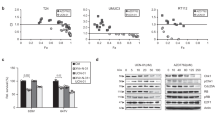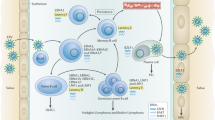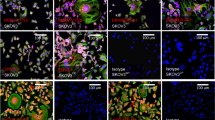Abstract
TUMOUR promoters of the diterpene type efficiently induce Epstein-Barr virus (EBV) and additional persisting herpes viruses in genome-harbouring lymphatic cells1,2. The tumour-promoting activity of these substances to some extent parallels their efficiency in virus induction2: the most active tumour promoters induce EBV even at concentrations of 10−10–10−9 M, whereas 100–500-fold higher concentrations are required for induction by weak promoters. Treatment of cells with tumour promoters results in a fast and reproducible increase in the activity of ornithine decarboxylase (ODC)3,4 up to 250-fold levels of normal activity. Recent reports5,6 described the inhibition of ODC induction by pretreating the cells with retinoic acid. Moreover, retinoic acid has been reported to act as an inhibitor in experimental 2-stage carcinogenesis models7. We have therefore investigated the possible interaction of retinoic acid with virus induction by tumour promoters. The effect of retinoic acid was also studied on the induction of early antigens (EA) of EBV by the pyrimidine analogue, iododeoxyuridine (lUdR)8,9, by treatment of IgM- producing cells with anti-IgM antibodies10 and by superinfection with EBV from P3HR-1 cells11,12. The data indicate that retinoic acid specifically interferes with induction by non-viral reagents without affecting EBV antigen synthesis after superinfection.
This is a preview of subscription content, access via your institution
Access options
Subscribe to this journal
Receive 51 print issues and online access
$199.00 per year
only $3.90 per issue
Buy this article
- Purchase on Springer Link
- Instant access to full article PDF
Prices may be subject to local taxes which are calculated during checkout
Similar content being viewed by others
References
zur Hausen, H., O'Neill, F., Freese, U.-K. & Hecker, E. Nature 272, 373–375 (1978).
zur Hausen, H., Bornkamm, G. W., Schmidt, R. & Hecker, E. Proc. natn. Acad. Sci. U.S.A.(in the press).
O'Brien, T. G., Simsiman, R. C. & Boutwell, R. K. Cancer Res. 35, 2426–2433 (1975).
O'Brien, T. G. Cancer Res. 36, 2644–2653 (1976).
Verma, A. K. & Boutwell, R. K. Cancer Res. 37, 2196–2201 (1977).
Kensler, T. W., Verma, A. K., Boutwell, R. K. & Mueller, G. C. Cancer Res. 38, 2896–2899 (1978).
Shamberger, R. J. J. natn. Cancer Inst. 47, 667–673 (1971).
Hampar, B., Derge, J. G., Martos, L. M. & Walker, G. L. Proc. natn. Acad. Sci. U.S.A. 69, 78–82 (1972).
Gerber, P. Proc. natn. Acad. Sci. U.S.A. 69, 83–85 (1972).
Tovey, M. G., Lenoir, G. & Begon-Lours Nature 276, 270–272 (1978).
Henle, W. et al. Science 169, 188–190 (1970).
Henle, G., Henle, W. & Klein, G. Int. J. Cancer 8, 272–282 (1971).
Tabor, H. & Tabor, C. W. J. biol. Chem. 244, 2286–2292 (1969).
Tabor, C. W. & Tabor, H. A. Rev. Biochem. 45, 282–206 (1976).
O'Brien, T. G., Simsiman, R. C. & Boutwell, R. K. Cancer Res. 36, 3766–3770 (1976).
Author information
Authors and Affiliations
Rights and permissions
About this article
Cite this article
YAMAMOTO, N., BISTER, K. & HAUSEN, H. Retinoic acid inhibition of Epstein-Barr virus induction. Nature 278, 553–554 (1979). https://doi.org/10.1038/278553a0
Received:
Accepted:
Published:
Issue Date:
DOI: https://doi.org/10.1038/278553a0
This article is cited by
-
Der m�gliche Einflu� von Vitamin A auf die Krebsentstehung in der HNO-Heilkunde
Archives of Oto-Rhino-Laryngology (1982)
-
Immunological features of psoriasis
Archives of Dermatological Research (1981)
Comments
By submitting a comment you agree to abide by our Terms and Community Guidelines. If you find something abusive or that does not comply with our terms or guidelines please flag it as inappropriate.



